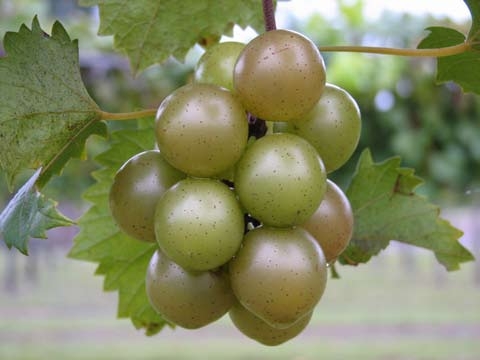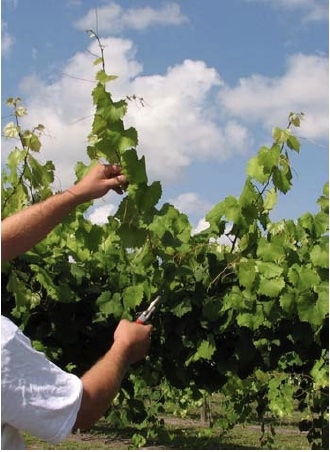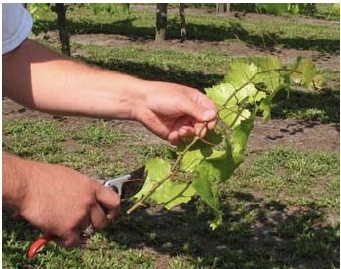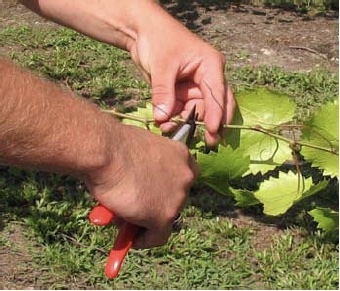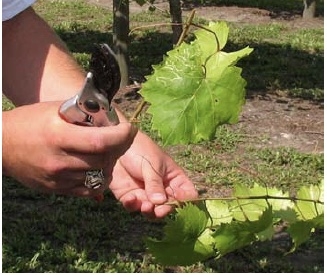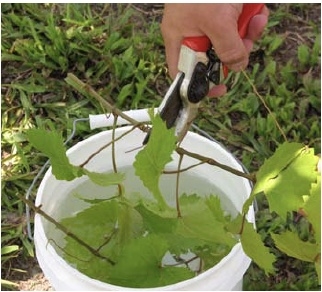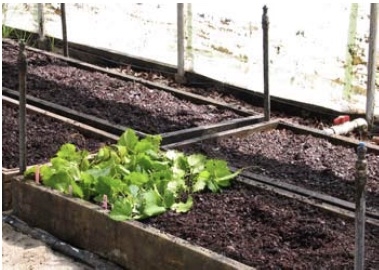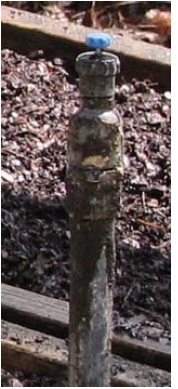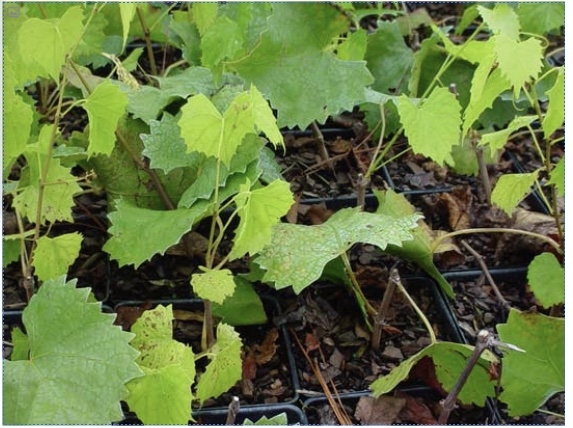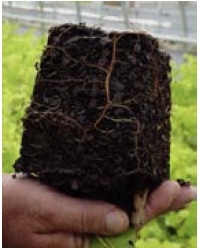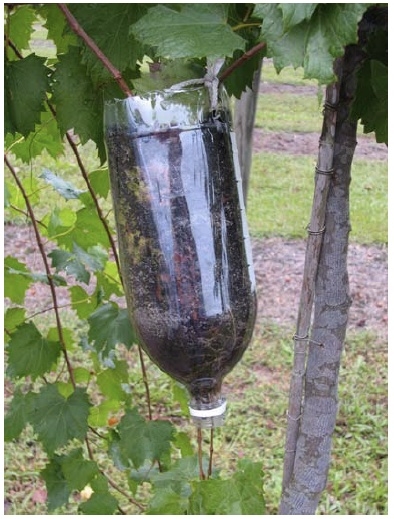Unlike propagation from seeds, propagation by cuttings or layering provides “true-to-type” vines that are identical to the parents in all varietal characteristics. If you want to start a new vineyard using a cultivar you like, or you need to replace damaged or diseased vines with the same cultivar, try propagating your vines with cuttings or layering. The processes are simple and take little time.
CAUTION
Muscadine plants that are patented and copyrighted cannot be propagated for any reason without written consent from the patent or copyright owner. Anyone in violation is subject to prosecution.
Propagation with Cuttings
Muscadine grapes are easy to propagate using softwood cuttings. The best time to take cuttings is when the vines are actively growing, in late May to early August. Before propagating a vine, determine whether or not the cultivar is patented (see Table 1 and Table 2). It is illegal to propagate patented cultivars without permission from the patent holder.
Selecting the parent vines: Always take cuttings from healthy, vigorous vines that have made good growth, have produced a good crop, are free of disease, and have not been pinched, topped, or severely injured. Vines that have suffered from drought or disease, or that have been defoliated by insects or frost, produce poor cuttings. Avoid wood from 1- or 2-year-old vines until trueness to type is established. Wood from vines that have carried excessive crops may be in a poorly nourished condition and should also be avoided.
The most desirable canes for cuttings are of medium size (less than or equal to pencil diameter) with internodes of moderate length (1 to 4 inches). Select wood that is still green but not excessively succulent. Use the basal portion of the shoot early in the season and the mid-portion later in the season.
| Cultivara | Characteristics | Plant Patent Numberd | Patent Filing Dated | Uses |
|---|---|---|---|---|
| Big Red©️ | Red, Female | Pending | Pending | Fresh, U-pick, Juice |
| Black Beauty©️ | Black, Female | 7592 | Mar 10, 1988 | Fresh, U-pick, Juice |
| Black Fry©️ | Black, Female | 5824 | Nov 9, 1984 | Fresh, U-pick, Juice |
| Darlene©️ | Bronze, Female | 7314 | Mar 10, 1988 | Fresh, U-pick, Juice |
| Dixie Red©️ | Red, Self-fertile | 4770 | Jul 1, 1976 | Wine, Juice, U-pick |
| Early Fryo©️ | Bronze, Female | 9225 | May 12, 1994 | Fresh, U-pick, Juice |
| Fry Seedless©️ | Pink, Self-fertile | 7296 | Mar 10, 1988 | Fresh, U-pick |
| Granny Val©️ | Bronze, Self-fertile | 5823 | Nov 9, 1984 | Fresh, U-pick |
| Ison©️ | Black, Self-fertile | 5822 | Nov 9, 1984 | Fresh, U-pick, Juice |
| Janebell©️ | Bronze, Self-fertile | 7268 | Mar 10, 1988 | Fresh, U-pick |
| Janet©️ | Bronze, Female | Pending | Pending | Fresh, U-pick |
| Late Fry©️ | Bronze, Self-fertile | 9224 | May 12, 1994 | Fresh, U-pick |
| Pam©️ | Bronze, Female | 7707 | Mar 10, 1988 | Fresh, U-pick, Juice |
| Pineapple©️ | Bronze, Self-fertile | 7266 | Mar 10, 1988 | Fresh, U-pick, Juice |
| Scarlettb | Red, Female | 11260 | Jul 24, 1997 | Fresh, U-pick, Juice |
| Southern Homec | Black, Self-fertile | 9454 | Dec 19, 1994 | Omamental, Wine |
| Sugargate©️ | Black, Female | 4056 | Sep 5, 1975 | Fresh, U-pick, Juice |
| Supreme©️ | Black, Female | 7267 | Mar 11, 1988 | Fresh, U-pick, Juice |
| Sweet Jenny©️ | Bronze, Female | 7265 | Mar 10, 1988 | Fresh, U-pick |
aIson’s Nursery in Brooks, GA, holds the patents to most of the above named cultivars. All except Southern Home are currently available for purchase, according to the 2008 catalog. Please call 1-800-733-0324 to purchase patented cultivars or to inquire about permission to propagate. ↲
bThe patent for Scarlett is held by Dr. Ron Lane of the University of Georgia Experiment Station. Scarlett is available through Ison’s Nursery in Brooks, GA, and Bottoms Nursery in Concord, GA. The two nurseries hold propagation rights to Scarlett under the university’s patent. ↲
cSouthern Home was patented by John Mortensen of the University of Florida, and plants are available through Bottoms Nursery in Concord, GA. ↲
dPlant patents are usually in effect for 20 years from the date the application for the patent was filed in the United States. Visit the U.S. Patent and Trademark Office Website for more information. ↲
Step-by-step instructions for propagating muscadine grapes from softwood cuttings
Step 1. Select a vigorous shoot and remove it from the vine. Each “whip” will yield two to four cuttings (Figure 1).
Step 2. Remove the lower two leaves (Figure 2). Then cut the stem between the fourth and fifth leaves—this is one “cutting” (Figure 3).
Step 3. Continue cutting the shoot into three- to four-node sections (about 4 to 6 inches each), removing the lower two leaves of each cutting (Figure 4). Discard the tender, young shoot tip (6 to 10 inches—Figure 5).
Step 4. Immediately place the cuttings in a bucket of room temperature water (Figure 6). Keep the cuttings moist until they are placed in the cutting bed. Some growers have found it beneficial to cut off half of each remaining leaf to reduce water lost through transpiration.
Step 5. Transport cuttings to a prepared bed and insert the end without leaves into propagation mix. About half of the cutting length should be below the soil –approximately two nodes (Figure 7). The mix pictured in Figure 7 is a pine bark “blueberry propagation” mix (approximately 1:1:1 peat:sand:bark). Any similar mix with good drainage and aeration would work. The pH of the mix is not as critical as proper drainage, and the mix usually doesn’t require amendments. In general, muscadines prefer a soil pH near 6.0.
Some growers have found it beneficial to dip the basal end of the cutting in Rootone®, but this may not be necessary depending on the cultivar being propagated.
Step 6. Set emitters to keep leaves moist, spraying for 5 seconds every 10 minutes throughout the day (using a “10-minute” clock). You don’t have to use any particular emitter—coarse or fine mist will work, so long as the leaves don’t wilt and water doesn’t sit in the potting mix. Muscadines do not like wet feet and will rot if too wet. Himelrick (2001) suggests using fine-aperture nozzles that deliver about 2 gallons of water per hour at 30-lb pressure. Nozzles should be spaced so that mist is evenly distributed over the entire bed (Figure 8). There is no need to irrigate at night.
An electric time clock is used to turn the nozzles on and off with a solenoid valve. For example, you can have a 24-hour clock that turns irrigation on during the day and off at night, and a separate clock that allows the emitters to come on every 10 minutes. Keep up this irrigation schedule long enough to allow the cuttings to root and start new shoot growth, usually 6 to 8 weeks. After that, irrigation frequency can gradually be reduced.
An alternative to the clock method is to use a leaf-wetness sensor to maintain optimum soil moisture.
Keep cuttings shaded from direct light and maintain good air circulation, such as leaving both ends of the house open.
After the cuttings go dormant in the fall, they can be bundled and heeled-in in a protected outdoor bed, transferred to pots, or stored bare root in moist sawdust at 40ºF to 45ºF to await planting the following spring. Fall planting of muscadines is not recommended due to the risk of cold injury.
The cutting bed: Make a rectangular frame out of 2- by 8-inch boards (Figure 8).
You may want to attach a wire mesh floor to the frame. Fill with a pine bark propagation mix, as discussed. If the bed is not inside an existing cold frame, construct a windbreak 2 to 3 feet high. Place the beds away from direct sunlight, or block direct sunlight using shadecloth, burlap, or similar material.
Propagation by Layering
Layering is another way to propagate a few vines at a time. Layering is also a good way to propagate varieties that may be hard to root by cuttings.
Root Layering: The simplest way of layering is to bend a healthy shoot down to the ground and bury a portion of it, leaving the tip end exposed (you can use a brick to hold it in place). After the vine goes dormant in the fall, the shoot can be dug and cut into rooted sections.
Air layering: Air layering is best accomplished when the vine is actively growing (May to August, as with cuttings). First, cut off the bottom of a plastic soda bottle (see Figure 11). Leave the shoot attached to the parent vine, and thread the growing point through the cut end of the bottle and out through the cap-end opening. Scarring the shoot helps the air layering process. Use a pocketknife to scrape down one side of the shoot to the cambium along the section that will be submerged in the mix. Fill the bottle with a pine bark propagation mix, such as a 1:1:1 mix of peat:sand:bark, and wet with room temperature water.
Rainwater usually suffices to keep the mix wet, but check occasionally and hand water as needed. After the vine goes dormant in the fall, remove the shoot from the parent vine and cut into rooted sections. These can then be potted or stored bare root in a refrigerated area (40ºF to 45ºF) to await planting the following spring.
References
- Fry, B. O. 1977. Muscadine grape. U.S. Patent Plant 4056.
- Fry, B. O. 1981. Muscadine grape. U.S. Patent Plant 4770.
- Himelrick, D. G. 2001. Clonal Propagation. In Muscadine Grapes, F. M. Basiouny and D. G Himelrick, eds. ASHS Press, Alexandria, VA.
- Ison’s Nursery & Vineyards. 2007. “Compendium and Catalog for the Grower of Muscadine Grapes and Other Fine Fruits and Berries.”
- Ison, W. G. 1986. Grapevine ‘Black Fry.’ U.S. Patent Plant 5824.
- Ison, W. G. 1986. ‘Granny Val’ Grapevine. U.S. Patent Plant 5823.
- Ison, W. G. 1986. Grapevine ‘Ison.’ U.S. Patent Plant 5822.
- Ison, W. G. 1990. ‘Darlene.’ U.S. Patent Plant 7314.
- Ison, W. G. 1990. ‘Fry Seedless.’ U.S. Patent Plant 7296.
- Ison, W. G. 1990. ‘Janebell.’ U.S. Patent Plant 7268.
- Ison, W. G. 1990. ‘Pineapple.’ U.S. Patent Plant 7266.
- Ison, W. G. 1990. ‘Supreme.’ U.S. Patent Plant 7267.
- Ison, W. G. 1990. ‘Sweet Jenny.’ U.S. Patent Plant 7265.
- Ison, W. G. 1991. ‘Black Beauty.’ U.S. Patent Plant 7592.
- Ison, W. G. 1991. Grapevine ‘Pam’. U.S. Patent Plant 7707.
- Ison, W. G. 1995. Muscadine grape ‘Early Fry.’ U.S. Patent Plant 9225.
- Ison, W. G. 1995. ‘Late Fry’ muscadine grape. U.S. Patent Plant 9224.
- Ison-Evans, Darlene. 2008. Personal communication.
- Lane, R. P. 2000. Muscadine grape plant ‘Scarlett’. U.S. Patent Plant 11260.
- Mortensen, J. A. 1996. Grape plant ‘Southern Home.’ U.S. Patent Plant 9454.
- Mortensen, J. A. 2001. Cultivars. In Muscadine Grapes, F.M. Basiouny and D. G. Himelrick, eds. ASHS Press, Alexandria, VA.
- U.S. Patent and Trademark Office. Plant patents. Accessed online on April 28, 2008.
- Winkler, A. J., J. A. Cook, W. M. Kliewer, and L. A Lider. 1974. Propagation. In General Viticulture. University of California Press, Berkeley, CA.
Prepared by:
Connie Fisk, Extension Associate, Muscadine Grapes, Dept. of Horticultural Science, N.C. State University
Benny Bloodworth, Agricultural Research Technician, Dept. of Plant Pathology, N.C. State University
Bill Cline, Extension Plant Pathologist, Dept. of Plant Pathology, N.C. State University
Whit Jones, Extension Agent, Horticulture, N.C. Cooperative Extension, Duplin County Extension Center, N.C. State University
Publication date: Jan. 1, 2008
Reviewed/Revised: Sept. 16, 2024
The use of brand names in this publication does not imply endorsement by NC State University or N.C. A&T State University of the products or services named nor discrimination against similar products or services not mentioned.
N.C. Cooperative Extension prohibits discrimination and harassment regardless of age, color, disability, family and marital status, gender identity, national origin, political beliefs, race, religion, sex (including pregnancy), sexual orientation and veteran status.

